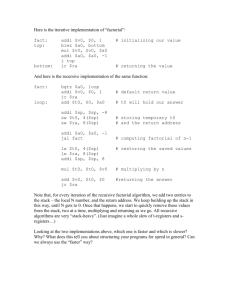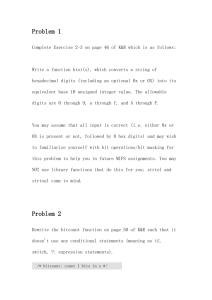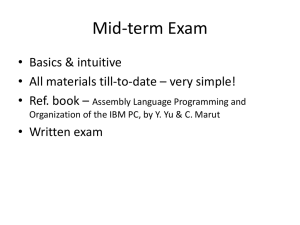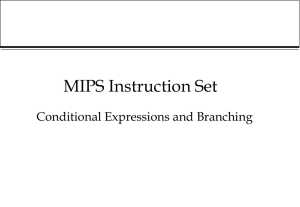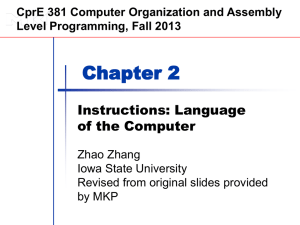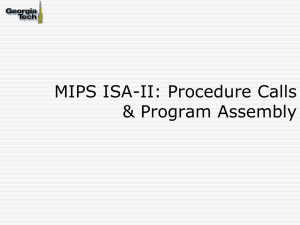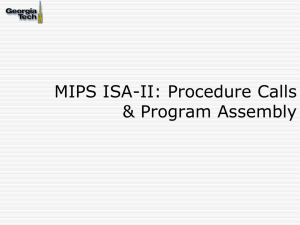Slide 1
advertisement
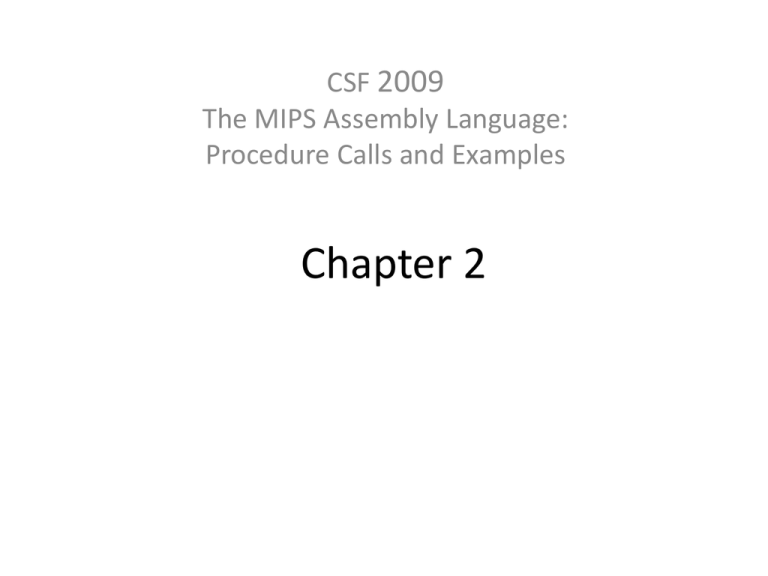
CSF 2009
The MIPS Assembly Language:
Procedure Calls and Examples
Chapter 2
Procedure Calling
•
Steps required
1.
2.
3.
4.
5.
6.
Place parameters in registers
Transfer control to procedure
Acquire storage for procedure
Perform procedure’s operations
Place result in register for caller
Return to place of call
Chapter 2 — Instructions: Language of
the Computer — 2
Register Usage
• $a0 – $a3: arguments (reg’s 4 – 7)
• $v0, $v1: result values (reg’s 2 and 3)
• $t0 – $t9: temporaries
– Can be overwritten by callee
• $s0 – $s7: saved
– Must be saved/restored by callee
• $gp: global pointer for static data (reg 28)
• $sp: stack pointer (reg 29)
• $fp: frame pointer (reg 30)
• $ra: return address (reg 31)
Chapter 2 — Instructions: Language of
the Computer — 3
Procedure Call Instructions
• Procedure call: jump and link
jal ProcedureLabel
– Address of following instruction put in $ra
– Jumps to target address
• Procedure return: jump register
jr $ra
– Copies $ra to program counter
– Can also be used for computed jumps
• e.g., for case/switch statements
Chapter 2 — Instructions: Language of
the Computer — 4
Procedure Example I
(One time call)
• C code:
int leaf_example (int g, h, i, j)
{ int f;
f = (g + h) - (i + j);
return f;
}
– Arguments g, …, j in $a0, …, $a3
– f in $s0 (hence, need to save $s0 on stack)
– Result in $v0
Chapter 2 — Instructions: Language of
the Computer — 5
Procedure Example I
(One time call)
• MIPS code:
proc_example:
addi $sp, $sp, -4
sw
$s0, 0($sp)
add $t0, $a0, $a1
add $t1, $a2, $a3
sub $s0, $t0, $t1
add $v0, $s0, $zero
lw
$s0, 0($sp)
addi $sp, $sp, 4
jr
$ra
Chapter 2 — Instructions: Language of
the Computer — 6
Save $s0 on stack
Procedure body
Result
Restore $s0
Return
Procedure Example II
(Multiple calls or Recursion)
• Procedures that call other procedures
• For nested call, caller needs to save on the
stack:
– Its return address
– Any arguments and temporaries needed after the
call
• Restore from the stack after the call
Chapter 2 — Instructions: Language of
the Computer — 7
Recursive Procedure Example
• C code:
int fact (int n)
{
if (n < 1) return f;
else return n * fact(n - 1);
}
– Argument n in $a0
– Result in $v0
Chapter 2 — Instructions: Language of
the Computer — 8
Recursive Procedure Example
• MIPS code:
fact:
addi
sw
sw
slti
beq
addi
addi
jr
L1: addi
jal
lw
lw
addi
mul
jr
$sp,
$ra,
$a0,
$t0,
$t0,
$v0,
$sp,
$ra
$a0,
fact
$a0,
$ra,
$sp,
$v0,
$ra
$sp, -8
4($sp)
0($sp)
$a0, 1
$zero, L1
$zero, 1
$sp, 8
$a0, -1
0($sp)
4($sp)
$sp, 8
$a0, $v0
#
#
#
#
adjust stack for 2 items
save return address
save argument
test for n < 1
#
#
#
#
#
#
#
#
#
#
if so, result is 1
pop 2 items from stack
and return
else decrement n
recursive call
restore original n
and return address
pop 2 items from stack
multiply to get result
and return
Local Data on the Stack
• Local data allocated by callee
– e.g., C automatic variables
• Procedure frame (activation record)
– Used by some compilers to manage stack storage
Chapter 2 — Instructions: Language of
the Computer — 10
Memory Layout
• Text: program code
• Static data: global variables
– e.g., static variables in C,
constant arrays and
strings
– $gp initialized to address
allowing ±offsets into
this segment
• Dynamic data: heap
– E.g., malloc in C, new in
Java
• Stack: automatic storage
Chapter 2 — Instructions: Language of
the Computer — 11
String Copy Example
• C code (naïve):
– Null-terminated string
void strcpy (char x[], char y[])
{ int i;
i = 0;
while ((x[i]=y[i])!='\0')
i += 1;
}
– Addresses of x, y in $a0, $a1
– i in $s0
Chapter 2 — Instructions: Language of
the Computer — 12
String Copy Example
• MIPS code:
strcpy:
addi
sw
add
L1: add
lbu
add
sb
beq
addi
j
L2: lw
addi
jr
$sp,
$s0,
$s0,
$t1,
$t2,
$t3,
$t2,
$t2,
$s0,
L1
$s0,
$sp,
$ra
$sp, -4
0($sp)
$zero, $zero
$s0, $a1
0($t1)
$s0, $a0
0($t3)
$zero, L2
$s0, 1
0($sp)
$sp, 4
#
#
#
#
#
#
#
#
#
#
#
#
#
adjust stack for 1 item
save $s0
i = 0
addr of y[i] in $t1
$t2 = y[i]
addr of x[i] in $t3
x[i] = y[i]
exit loop if y[i] == 0
i = i + 1
next iteration of loop
restore saved $s0
pop 1 item from stack
and return
Chapter 2 — Instructions: Language of
the Computer — 13
C Sort Example
• Illustrates use of assembly instructions for a
C bubble sort function
• Swap procedure (leaf)
void swap(int v[], int k)
{
int temp;
temp = v[k];
v[k] = v[k+1];
v[k+1] = temp;
}
– v in $a0, k in $a1, temp in $t0
Chapter 2 — Instructions: Language of
the Computer — 14
The Procedure Swap
swap: sll $t1, $a1, 2
# $t1 = k * 4
add $t1, $a0, $t1 # $t1 = v+(k*4)
#
(address of v[k])
lw $t0, 0($t1)
# $t0 (temp) = v[k]
lw $t2, 4($t1)
# $t2 = v[k+1]
sw $t2, 0($t1)
# v[k] = $t2 (v[k+1])
sw $t0, 4($t1)
# v[k+1] = $t0 (temp)
jr $ra
# return to calling routine
Chapter 2 — Instructions: Language of
the Computer — 15
The Sort Procedure in C
• Non-leaf (calls swap)
void sort (int v[], int n)
{
int i, j;
for (i = 0; i < n; i += 1) {
for (j = i – 1;
j >= 0 && v[j] > v[j +
1];
j -= 1) {
swap(v,j);
}
Chapter 2 — Instructions: Language of
}
the Computer — 16
move
move
move
for1tst: slt
beq
addi
for2tst: slti
bne
sll
add
lw
lw
slt
beq
move
move
jal
addi
j
exit2:
addi
j
The Procedure Body
$s2, $a0
$s3, $a1
$s0, $zero
$t0, $s0, $s3
$t0, $zero, exit1
$s1, $s0, –1
$t0, $s1, 0
$t0, $zero, exit2
$t1, $s1, 2
$t2, $s2, $t1
$t3, 0($t2)
$t4, 4($t2)
$t0, $t4, $t3
$t0, $zero, exit2
$a0, $s2
$a1, $s1
swap
$s1, $s1, –1
for2tst
$s0, $s0, 1
for1tst
#
#
#
#
#
#
#
#
#
#
#
#
#
#
#
#
#
#
#
#
#
save $a0 into $s2
save $a1 into $s3
i = 0
$t0 = 0 if $s0 ≥ $s3 (i ≥ n)
go to exit1 if $s0 ≥ $s3 (i ≥ n)
j = i – 1
$t0 = 1 if $s1 < 0 (j < 0)
go to exit2 if $s1 < 0 (j < 0)
$t1 = j * 4
$t2 = v + (j * 4)
$t3 = v[j]
$t4 = v[j + 1]
$t0 = 0 if $t4 ≥ $t3
go to exit2 if $t4 ≥ $t3
1st param of swap is v (old $a0)
2nd param of swap is j
call swap procedure
j –= 1
jump to test of inner loop
i += 1
jump to test of outer loop
Chapter 2 — Instructions: Language of
the Computer — 17
Move
params
Outer loop
Inner loop
Pass
params
& call
Inner loop
Outer loop
The Full Procedure
sort:
addi $sp,$sp, –20
sw $ra, 16($sp)
sw $s3,12($sp)
sw $s2, 8($sp)
sw $s1, 4($sp)
sw $s0, 0($sp)
…
…
exit1: lw $s0, 0($sp)
lw $s1, 4($sp)
lw $s2, 8($sp)
lw $s3,12($sp)
lw $ra,16($sp)
addi $sp,$sp, 20
jr $ra
#
#
#
#
#
#
#
make room on stack for 5 registers
save $ra on stack
save $s3 on stack
save $s2 on stack
save $s1 on stack
save $s0 on stack
procedure body
#
#
#
#
#
#
#
restore $s0 from stack
restore $s1 from stack
restore $s2 from stack
restore $s3 from stack
restore $ra from stack
restore stack pointer
return to calling routine
Chapter 2 — Instructions: Language of
the Computer — 18
Effect of Compiler Optimization
Compiled with gcc for Pentium 4 under Linux
Chapter 2 — Instructions: Language of
the Computer — 19
Effect of Language and Algorithm
Chapter 2 — Instructions: Language of
the Computer — 20
Arrays vs. Pointers
• Array indexing involves
– Multiplying index by element size
– Adding to array base address
• Pointers correspond directly to memory
addresses
– Can avoid indexing complexity
Chapter 2 — Instructions: Language of
the Computer — 21
Example: Clearing and Array
clear1(int array[], int size) {
int i;
for (i = 0; i < size; i += 1)
array[i] = 0;
}
clear2(int *array, int size) {
int *p;
for (p = &array[0]; p < &array[size];
p = p + 1)
*p = 0;
}
move $t0,$zero
loop1: sll $t1,$t0,2
add $t2,$a0,$t1
move $t0,$a0
# p = & array[0]
sll $t1,$a1,2
# $t1 = size * 4
add $t2,$a0,$t1 # $t2 =
#
&array[size]
loop2: sw $zero,0($t0) # Memory[p] = 0
addi $t0,$t0,4 # p = p + 4
slt $t3,$t0,$t2 # $t3 =
#(p<&array[size])
bne $t3,$zero,loop2 # if (…)
# goto loop2
# i = 0
# $t1 = i * 4
# $t2 =
#
&array[i]
sw $zero, 0($t2) # array[i] = 0
addi $t0,$t0,1
# i = i + 1
slt $t3,$t0,$a1 # $t3 =
#
(i < size)
bne $t3,$zero,loop1 # if (…)
# goto loop1
Chapter 2 — Instructions: Language of
the Computer — 22
Comparison of Array vs. Ptr
• Multiply “strength reduced” to shift
• Array version requires shift to be inside loop
– Part of index calculation for incremented i
– c.f. incrementing pointer
• Compiler can achieve same effect as manual
use of pointers
– Induction variable elimination
– Better to make program clearer and safer
Chapter 2 — Instructions: Language of
the Computer — 23
